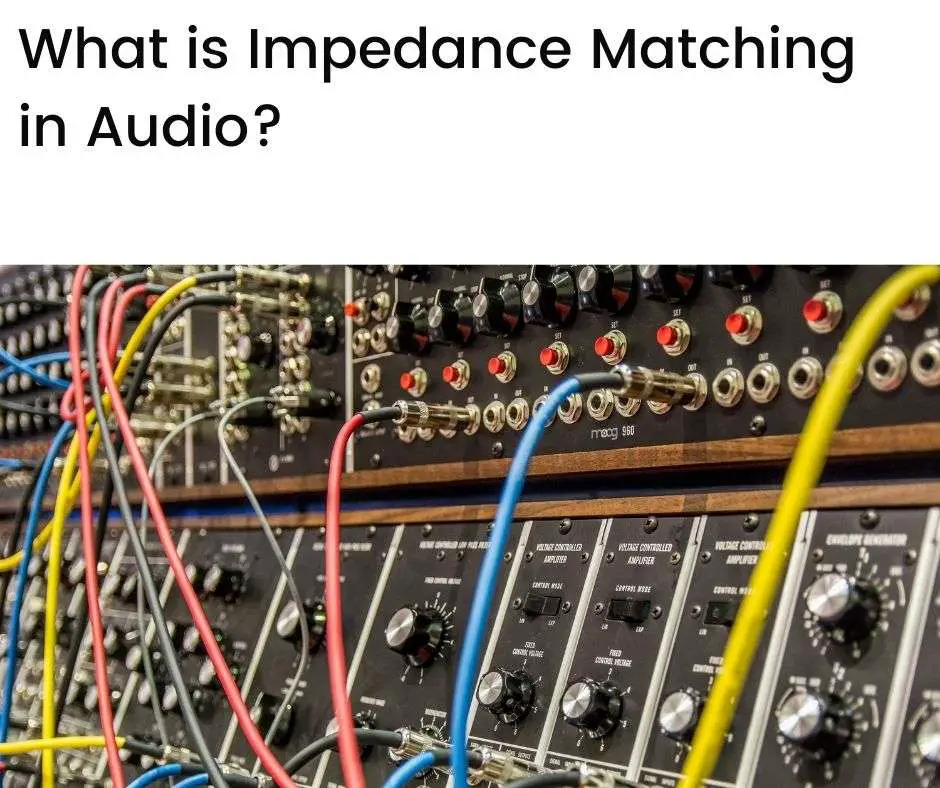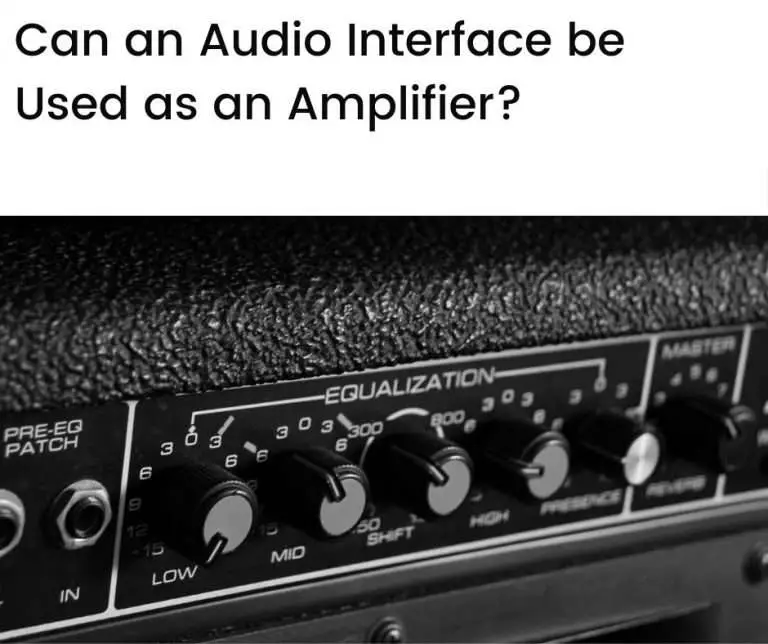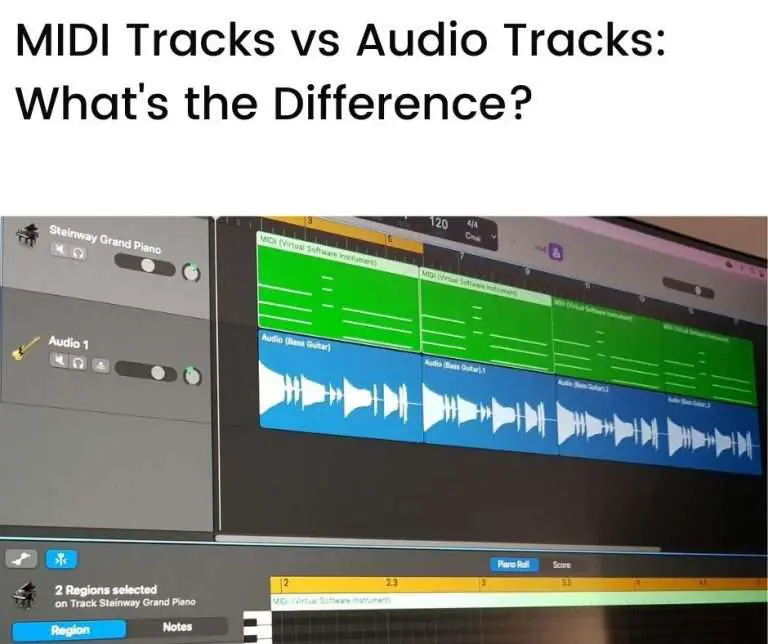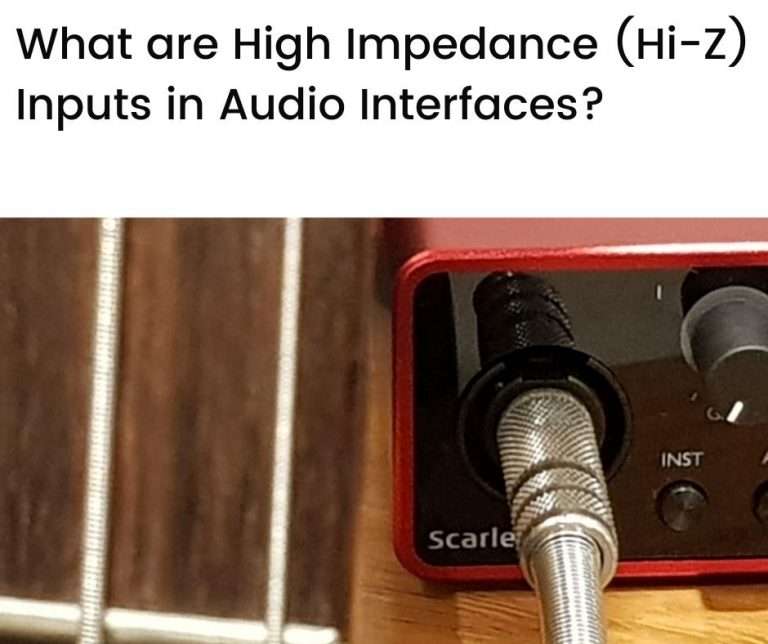Impedance matching refers to using equal impedances when connecting two or more electronic devices. This allows for the maximum transfer of power between the devices. While impedance matching was important in early (analog) telephone and audio systems, it is less important today. Modern audio systems prioritize signal transfer rather than power transfer. There are some instances, however, when impedance matching still has a role to play.
In this article we’ll look at:
What is impedance matching?
Impedance matching refers to having the same impedance for each device when connecting two (or more) electronic devices. This is sometimes referred to as having a balanced impedance between the devices.
(Technically speaking, impedance matching refers to one impedance being the conjugate of another impedance when two devices are connected, but that’s a level of detail that’s beyond this article)
What is impedance?
Impedance is the term given to the resistance that electronic circuit components offer against the flow of alternating current (AC).
Impedance is related to the resistance against direct current (DC) in most circuit components, but includes the “additional resistance” from capacitive and inductive circuit elements that vary with frequency.
For DC circuits, the relationship between voltage (volts, V), current (amps, A), and resistance (ohms, Ω) is described by Ohm’s law:
V = I x R
When applied to AC circuits, Ohm’s law is modified to include impedance, as follows:
V = I x Z
Here, impedance is also measured in ohms and uses the symbol Z.
Why is impedance matching important?
When connecting two electronic devices, impedance matching allows a maximum power transfer between the devices.
Power in electronic circuits is measured in watts (W) and is described using the following relationship:
P = I x V
Where, P is the power (W) in a circuit, with a current I (A) flowing through it, and a voltage V (V) applied across it.
To see how this works, consider two devices connected to each other: A source device and an input device.
Let’s assume a source voltage of 10 V and a source impedance of 10 Ω. This setup is shown below:

The graph below shows how the input power and input voltage vary for the input device, as the input impedance is changed:
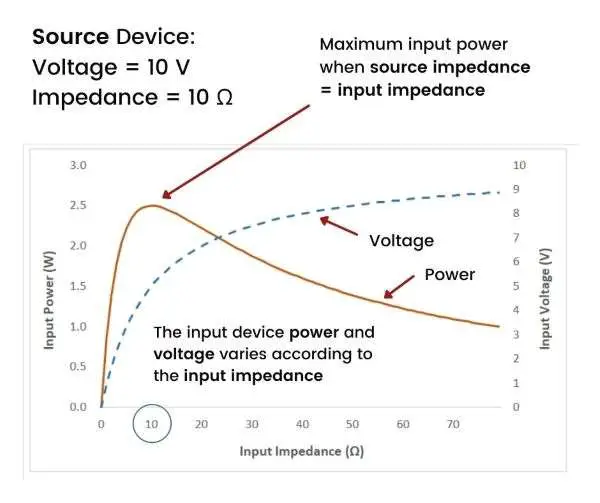
In the above graph, notice how the power flowing through the input device is at a maximum when the input impedance equals the source impedance (10 Ω)—this is the reason why impedance matching is important, as it allows for the maximum transfer of power.
Impedance matching in audio
In the early days of the telephone industry—where much of modern audio technology has its origins—unmatched impedances between connecting systems resulted in energy reflections between the systems. This led to echoes or distortions and generally deteriorated the quality of audio communications.
As we know, impedance matching allows a maximum transfer of power. Since power and energy are related, i.e., power is simply the rate of energy transfer, it’s not surprising that maximum power transfer and maximum energy transfer are related concepts.
The knowledge of early telephone systems and the analog technology that accompanied them were carried over to music systems in later years. In these early music systems, impedance matching had an important role to play.
In early audio systems, enough power needed to be transferred from microphones and pre-amps to drive the loudspeakers that were used at the time. This called for careful optimization of impedances between devices using impedance matching techniques.
The development of modern integrated circuit amplifiers, however, greatly reduced the need for optimizing power transfer in audio systems.
Modern audio systems prioritize signal (voltage) transfer
In most modern audio environments, power (or energy) transfer isn’t the priority. Rather, maximum signal transfer, i.e., the maximum transfer of source voltage, is the priority.
In the above graph, we saw that power transfer is maximized when impedances are matched (equal) between the source and input devices. You’ll also notice that the input voltage increases as the input impedance increases, relative to the source impedance—this is the reason why you’ll often find high input impedances on audio equipment, to allow a high degree of voltage (signal) transfer from source devices.
This approach of using a high input impedance relative to a source impedance is sometimes called impedance bridging.
The technology and applications of modern audio equipment are very different from the early days of the telephone industry. Digital technology is widely used, for instance, and energy transfer issues do not generally arise in modern audio production (or listening) environments.
So, impedance matching is less important in modern audio systems.
When impedance matching still matters in audio systems
There are some instances, however, when impedance matching still has a role to play in audio applications—let’s look at some of these:
1. Impedance matching speakers with amplifiers
As mentioned, impedance matching is less important when using modern integrated circuit amplifiers. These amplifiers use transistors that utilize maximum voltage transfer more efficiently than maximum power transfer.
Older amplifiers, however, i.e., valve or “tube” amplifiers, still rely on impedance matching to optimize power transfer to speaker systems.
Even with integrated circuit amplifiers, however, there are two reasons for paying attention to the impedance of connected speakers:
- It’s generally better to have speaker impedances that are higher than the amp’s output impedance—this is to prevent the possibility of (low impedance) speakers drawing too much current from the amp and burning out
- While maximum power transfer isn’t a priority, the amp needs to have sufficient power to drive the speakers—if the speakers’ impedances are too high, it will not draw enough power to work well
So, when connecting integrated circuit amplifiers to speakers, some degree of impedance matching is required. Speaker impedances need to be high enough to prevent burnout, but not too high, so they have sufficient power to work well.
2. Impedance pairing headphones with source devices
Headphones come with a range of impedance levels, typically between 8 Ω and 600 Ω.
When using headphones with connected source devices, e.g., laptops, smartphones, amplifiers, or audio interfaces, it’s better to match—or pair—the impedance of the headphones with the source device as much as possible.
This is because of how impedance affects sound quality in headphones. When you pair headphones with a source device you’ll get a better sound—good volume, solid bass, better transparency, and more clarity.
You can pair your headphones to source devices by:
- Using lower impedance headphones with low voltage and power sources like smartphones and laptops
- Using higher impedance headphones with high voltage and power sources like amps and mains-powered audio interfaces
When using headphones, both signal transfer and power transfer matter. By pairing your headphones and source impedances, you’re ensuring that:
- The source device has sufficient power to drive the headphones—a smartphone, for instance, may simply not have enough power to drive high impedance headphones (i.e., you’ll hear a very low volume and inadequate sound quality)
- A large proportion (or a maximum) of power is transferred to the headphones to provide the best sound quality
Impedance matching, therefore, is relevant for pairing headphones with sourced devices.
3. Matching microphones to input devices
Impedance matching of microphones to input devices (e.g., the pre-amps found in audio interfaces) is no longer an issue in modern systems. Nevertheless, a “moderate degree” of impedance matching is still used.
As a “rule of thumb”, an input impedance that’s at least ten times a source impedance helps to maximize voltage transfer when using impedance bridging.
In many instrument inputs (e.g., an electric guitar plugged directly into an audio interface), the input impedance may be 1 MΩ and the guitar (source) impedance may be 10 kΩ—that’s a 100-fold difference in impedance.
Microphone inputs, however, typically have much lower impedances.
A typical microphone (source) impedance may be 200 Ω, while typical microphone (input) impedances may be 1,000 Ω—that’s only a 5-fold increase, which is far more modest than the 100-fold increase noted above for instrument inputs.
Microphone inputs are treated this way in order to balance the voltage (signal) transfer with power transfer—both are considered important in the case of microphones. Hence, some degree of impedance matching is still prioritized for modern microphone connections.
Conclusion
Impedance matching refers to the situation when the impedances of connected devices are equal. This allows for the maximum transfer of power between the devices.
Impedance matching was important in the early years of telephony and in early audio systems. This is because they used analog equipment, sometimes over long distances (as in telephone systems), and optimizing power transfer was important for their proper functioning.
In modern audio systems, however, power transfer is no longer a priority. Integrated circuit amplifiers and digital technology have reduced the need to optimize power transfer. Rather, signal (voltage) transfer is the priority.
Nevertheless, there are some instances when impedance matching is still important in audio systems. These include when valve amplifiers are used to connect to speaker systems, when pairing headphones with source devices, and when microphones are connected to input devices.
While impedance matching had an important role to play in the evolution of modern audio equipment, it is less relevant today. Being aware of the different levels of impedance in any audio system, however, remains an important consideration for how these systems operate.

